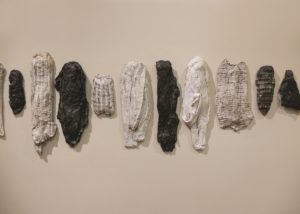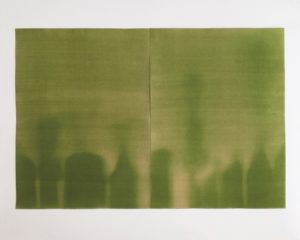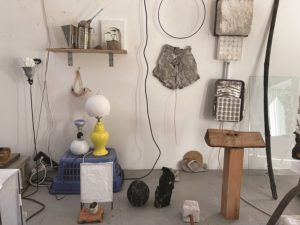Erin Woodbrey’s Orleans studio overlooks her garden, now full of late-season vegetables and flowers. The garden provides food, inspiration, and the natural dyes that Woodbrey uses for her prints.
Woodbrey also makes sculptures, installations, and photographs. “The through line of the work is time,” she says. “I’ve always been fascinated with trying to understand how it materializes, what our experience of time is.” What also unifies Woodbrey’s work is playfulness, an interest in the natural world, and a strong poetic undertow.

Woodbrey grew up outside Portland, Maine. She moved to Boston and then Chicago, earning degrees at the School of the Museum of Fine Arts and the School of the Art Institute of Chicago.
Woodbrey worked summers at the Truro Center for the Arts at Castle Hill. After finishing graduate school in 2014, she returned, and not long after poured the foundation for the house she lives in today. She has been showing her work at Provincetown’s Gaa Gallery since 2015, where she is also the director.
Her newest show includes 11 works from her Fragment series in “Vision 2021: Found, Formed, Fused” at the Cape Cod Museum of Art. The group exhibition features artists who use found or recycled materials.

Woodbrey takes her own clothing, dips it in porcelain, and drapes it over a wooden frame that, along with the fabric, burns away during the firing process. What is left is a sort of fossil. “I’m trying to replicate geological happenings,” says Woodbrey. “There are strata and layers, as well as heat and chemical reactions.”
Black India ink is applied to emphasize the textured surface. The result resembles charred wood. “I like the cracks — the evidence of the time and temperature that the fabric went through,” she says. For the process to work, the materials must be totally organic: plastic and polyester melt. Woodbrey says she’s become more aware of the sustainability of the clothing she buys as a result.

Last year, she took an online course on shadowgrams — prints that use photosensitive emulsions made from spinach, beets, or cabbage to track light passing over found objects. There are a few laid out under a window in her studio, following “the way the shadow goes across them over the course of the day.” The results are often unpredictable
Also in Woodbrey’s studio are large, deconstructed books, the pages layered with plaster so that they resemble swollen appendages. Encased in this hard shell, the words and ideas in these books are preserved, in a sense, but inaccessible. In another corner of the studio are clusters of single-use plastic containers that Woodbrey has covered in ash, plaster, and gauze and mounted, upside-down, onto tomato cages made from steel wire. The effect is haunting.

One wall of Woodbrey’s studio hosts a seemingly random collection of objects — an inverted plastic laundry basket, light fixtures, black plastic tubing, an old paint tray, long cables, and a wooden pedestal. They are laid out in an almost scientific manner — cast-offs waiting to be incorporated in her future work.
“I’m interested in the meaning embedded in objects and how they form our experiences,” says Woodbrey. “We’re developing all these technologies, and there’s a certain point where the technology starts making us. I’m interested in that reciprocity.”

Woodbrey wants viewers to be participants in her work — understanding takes time and curiosity. “I want it be confusing. I’m OK with that,” she says. “Sometimes my work can be a bit opaque, but I hope that grounding it in objects and things makes it accessible.”
For Woodbrey, it all comes back to the garden, which has taught her “the interconnectedness of all things” — the pace a
nd rhythm of nature. “Last week, I watched the migratory birds fly through. I think a lot about listening to things, looking closely, and slowing down to focus on the moment.”
What’s Left Behind
The event: Works by Erin Woodbrey, part of “Vision 2021: Found, Formed, Fused”
The time: Through Nov. 14
The place: Cape Cod Museum of Art, 60 Hope Lane, Dennis
The cost: General admission, $10



